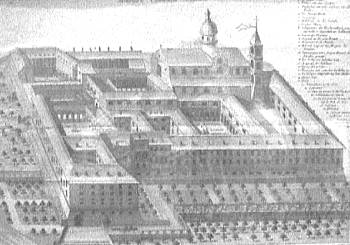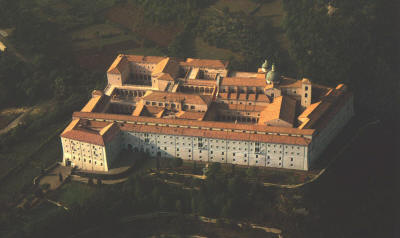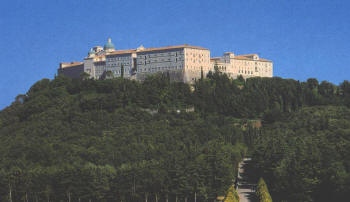The exact time and
place at which St. Benedict wrote his Rule are not known, nor can it be
determined whether the Rule, as we now possess it, was composed as a single
whole or whether it gradually took shape in response to the needs of his monks.
Somewhere about 530 however, may be taken as a likely date, and Monte Cassino as
a more probable place than Subiaco, for the Rule certainly reflects St.
Benedict's matured monastic and spiritual wisdom. The earliest chronicler says
that when
 Monte Cassino was destroyed by the Lombards in 581, the monks fled to
Rome, carrying with them, among other treasures, a copy of the Rule "which the
holy Father had composed"; and in the middle of the eighth century there was in
the pope's library a copy believed to be St. Benedict's autograph. It has been
assumed by many scholars that this was the copy brought from Monte Cassino; but
though this is likely enough, it is not a certainty. Be that as it may, this
manuscript of the Rule was presented by Pope Zachary to Monte Cassino in the
middle of the eighth century, a short time after the restoration of that
monastery. Charlemagne found it there when he visited Monte Cassino towards the
end of the century, and at his request a most careful transcript of it was made
for him, as an exemplar of the text to be disseminated throughout the
monasteries of his empire. Several copies of the Rule were made from it, one of
which survives to this day; for there can be no doubt that the present Codex 914
of the St. Gall Library was copied directly from Charlemagne's copy for the Abby
of Reichnau. An exact diplomatic reprint (not in facsimile) of this codex was
published at Monte Cassino in 1900, so that the text of this manuscript,
certainly the best individual text of the Rule in existence, can be studied
without difficulty. Various other manuscripts go back to Charlemagne's
manuscript, or to its original at Monte Cassino, which was destroyed by fire in
896, and thus the text of the so-called autograph may be restored by approved
critical methods with quite unusual certainty, and could we be certain that it
really was the autograph, there would be no more to say.
Monte Cassino was destroyed by the Lombards in 581, the monks fled to
Rome, carrying with them, among other treasures, a copy of the Rule "which the
holy Father had composed"; and in the middle of the eighth century there was in
the pope's library a copy believed to be St. Benedict's autograph. It has been
assumed by many scholars that this was the copy brought from Monte Cassino; but
though this is likely enough, it is not a certainty. Be that as it may, this
manuscript of the Rule was presented by Pope Zachary to Monte Cassino in the
middle of the eighth century, a short time after the restoration of that
monastery. Charlemagne found it there when he visited Monte Cassino towards the
end of the century, and at his request a most careful transcript of it was made
for him, as an exemplar of the text to be disseminated throughout the
monasteries of his empire. Several copies of the Rule were made from it, one of
which survives to this day; for there can be no doubt that the present Codex 914
of the St. Gall Library was copied directly from Charlemagne's copy for the Abby
of Reichnau. An exact diplomatic reprint (not in facsimile) of this codex was
published at Monte Cassino in 1900, so that the text of this manuscript,
certainly the best individual text of the Rule in existence, can be studied
without difficulty. Various other manuscripts go back to Charlemagne's
manuscript, or to its original at Monte Cassino, which was destroyed by fire in
896, and thus the text of the so-called autograph may be restored by approved
critical methods with quite unusual certainty, and could we be certain that it
really was the autograph, there would be no more to say.
But as already pointed out, it is
not quite certain that it was St. Benedict's autograph, and the case is
complicated by the circumstance that there is in the field another type of text,
represented by the oldest known manuscript, the Oxford Hatton manuscript 42, and
by other very early authorities, which certainly was the text most widely
diffused in the seventh and eighth centuries. Whether this text was St.
Benedict's
 first recension and the "autograph" his later revision, or whether
the former is but a corrupted form of the latter, is a question which is still
under debate, though the majority of critics lean towards the second
alternative. In either case, however, the text of the "autograph" is the one to
be adopted. The manuscripts, from the tenth century onwards, and the ordinary
printed editions, give mixed texts, made up out of the two earliest types. Thus
the text in current use is critically a bad one, but very few of the readings
make any substantial difference.
first recension and the "autograph" his later revision, or whether
the former is but a corrupted form of the latter, is a question which is still
under debate, though the majority of critics lean towards the second
alternative. In either case, however, the text of the "autograph" is the one to
be adopted. The manuscripts, from the tenth century onwards, and the ordinary
printed editions, give mixed texts, made up out of the two earliest types. Thus
the text in current use is critically a bad one, but very few of the readings
make any substantial difference.
The Rule was written in the Lingua
Vulgaris or Low Latin vernacular of the time, and contains much syntax and
orthography not in conformance with the classical models. There is as yet no
edition of the Rule that satisfies the requirements of modern criticism, though
one is in process of preparation for the Vienna "Corpus" of Latin Ecclesiastical
writers. A sufficiently good manual edition was published by Dom Edmund Schmidt.
of Metten, at Ratisbon in 1892, presenting in substance the text of St. Gall
manuscript, with the Low Latin element eliminated.
The
number of commentators on the rule is legion. Calmet gives a list of over a
hundred and thirty such writers, and Ziegelbauer gives a similar list. The
earliest commentary, in point of date, is that which has been variously ascribed
to Paul Warnefrid (a monk of
Monte
Cassino about 780-799), Hildemar, Ruthard of
Hirsau, and others. Hildemar, a Gallic monk, brought to Italy by Angelbert,
Archbishop of Milan, reformed the monastery of Sts. Faustinus and Jovita at
Brescia and died in 840. Martène, who considered this commentary to be the best
ever produced, maintained that Hildemar was its real author, but modern critics
attribute it to Paul Warnefrid. Amongst other commentators the following deserve
mention: St. Hildegard (d. 1178), the foundress and first Abbess of Mount St.
Rupert, near Bingen on the Rhine, who held that St. Benedict's prohibition of
flesh-meat did not include that of birds; Bernard, Abbot of
Monte
Cassino, formerly of Lérins and afterwards a
Cardinal (d. 1282); Turrecremata (Torquemada) a Dominican (1468); Trithemius,
Abbot of Sponheim (1516); Perez, Archbishop of Tarragona and Superior-General of
the congregation of Valladolid; Haeften, Prior of Afflighem (1648); Stengel,
Abbot of Anhausen (1663); Mège (1691) and Martène (1739) Maurists; Calmet, Abbot
of Senones (1757); and Mabillon (1707), who discusses at length several portions
of the Rule in his Prefaces to the different volumes of the "Acta Sanctorum
O.S.B."
It is impossible to gauge the
comparative value of these and other commentaries, because the different authors
treat the Rule from different points of view. That of Calmet is perhaps the most
literal and exhaustive on many important points; those of Martène and Haeften
are mines of information regarding monastic tradition: Perez and Mège are
practical and pious, though the latter has been considered lax in many
 of the
views maintained; that of Turrecremata is useful as treating the Rule from the
standpoint of moral theology; and others give mystical interpretations of its
contents. It may be pointed out that in studying the Rule as a practical code of
monastic legislation, it is necessary to facilitate uniformity of observance,
each congregation of the order has its own constitutions, approved by the Holy
See, by which are regulated many of the matters of detail not touched upon by
the Rule itself.
of the
views maintained; that of Turrecremata is useful as treating the Rule from the
standpoint of moral theology; and others give mystical interpretations of its
contents. It may be pointed out that in studying the Rule as a practical code of
monastic legislation, it is necessary to facilitate uniformity of observance,
each congregation of the order has its own constitutions, approved by the Holy
See, by which are regulated many of the matters of detail not touched upon by
the Rule itself.
Before proceeding to analyze St.
Benedict's Rule and to discuss its leading characteristics, something must be
said about the monasticism that preceded his times, and out of which his system
grew, in order that some idea may be gained as to how much of the Rule was
borrowed from his precursors and how much was due to his own initiative. Such
considerations are important because there is no doubt whatever that the
introduction and propagation of St. Benedict's Rule was the turning-point which
changed the whole trend of monasticism in the West.
The earliest forms of Christian
monachism were characterized by their extreme austerity and by their more or
less eremetical nature. In Egypt, the followers of St. Anthony were purely
eremetical, whilst those who followed the Rule of St. Pachomius, though they
more nearly approached the cenobitical ideal, were yet without that element of
stability insisted upon by St. Benedict, viz: the "common life" and family
spirit. Under the Antonian system the austerities of the monks were left
entirely to their own discretion; under the Pachomian, though there was an
obligatory rule of limited severity, the monks were free to add to it what other
ascetical practices they chose. And in both, the
 prevailing idea was that they
were spiritual athletes, and as such they rivaled each other in austerity.
Syrian and strictly Oriental monasticism need not be considered here, as it had
no direct influence on that of Europe. When St. Basil (fourth century) organized
Greek monasticism, he set himself against the eremetical life and insisted upon
a community life, with meals, work, and prayer, all in common. With him the
practice of austerity, unlike that of the Egyptians, was to be subject to
control of the superior, for he considered that to wear out the body by
austerities so as to make it unfit for work, was a misconception of the
Scriptural precept of penance and mortification. His idea of the monastic life
was the result of the contact of primitive ideas, as existing in Egypt and the
East, with European culture and modes of thought.
prevailing idea was that they
were spiritual athletes, and as such they rivaled each other in austerity.
Syrian and strictly Oriental monasticism need not be considered here, as it had
no direct influence on that of Europe. When St. Basil (fourth century) organized
Greek monasticism, he set himself against the eremetical life and insisted upon
a community life, with meals, work, and prayer, all in common. With him the
practice of austerity, unlike that of the Egyptians, was to be subject to
control of the superior, for he considered that to wear out the body by
austerities so as to make it unfit for work, was a misconception of the
Scriptural precept of penance and mortification. His idea of the monastic life
was the result of the contact of primitive ideas, as existing in Egypt and the
East, with European culture and modes of thought.
Monasticism came into Western Europe
from Egypt. In Italy, as also in Gaul, it was chiefly Antonian in character,
though both the rules of St. Basil and St. Pachomius were translated into Latin
and doubtless made their influence felt. As far as we know, each monastery had
practically its own rule, and we have examples of this irresponsible form of
monastic life in the community St. Benedict was called from his cave to govern,
and in the Gyrovagi and Sarabitae whom he mentions in terms of condemnation in
the first chapter of his Rule. A proof that the pervading spirit of Italian
monachism was Egyptian lies in the fact that when St. Benedict determined to
forsake the world and become a monk, he adopted, almost as a matter of course,
the life of a solitary in a cave. His familiarity with the rules and other
documents bearing upon the life of the Egyptian monks is shown by his
legislating for the daily reading of the "Conferences" of Cassian, and by his
recommendation (c. 73) of the "Institutes" and "Lives" of the Fathers and the
Rule of St. Basil.
When, therefore, St. Benedict came
to write his own Rule for the monasteries he had founded, he embodied in it the
result of his own mature experience and observation. He had himself lived the
life of a solitary after the most extreme Egyptian pattern, and in his first
communities he had no doubt thoroughly tested the prevailing type of monastic
rule. Being fully cognizant, therefore, of the unsuitability of much in the
Egyptian systems to the times and circumstances in which he lived, he now struck
out on a new line, and instead of attempting to revivify the old forms of
asceticism, he consolidated the cenobitical life, emphasized the family spirit,
and discouraged all private venture in austerities. His Rule thus consists of a
carefully considered combination of old and new ideas; rivalry in austerity was
eliminated, and there was to be henceforth a sinking of the individual in the
community. In adapting a system essentially Eastern, to Western conditions, St.
Benedict gave it coherence, stability, and organization, and the verdict of
history is unanimous in applauding the results of such adaptation.
History of the Rule from the Catholic
Encyclopedia (1911)
 Monte Cassino was destroyed by the Lombards in 581, the monks fled to
Rome, carrying with them, among other treasures, a copy of the Rule "which the
holy Father had composed"; and in the middle of the eighth century there was in
the pope's library a copy believed to be St. Benedict's autograph. It has been
assumed by many scholars that this was the copy brought from Monte Cassino; but
though this is likely enough, it is not a certainty. Be that as it may, this
manuscript of the Rule was presented by Pope Zachary to Monte Cassino in the
middle of the eighth century, a short time after the restoration of that
monastery. Charlemagne found it there when he visited Monte Cassino towards the
end of the century, and at his request a most careful transcript of it was made
for him, as an exemplar of the text to be disseminated throughout the
monasteries of his empire. Several copies of the Rule were made from it, one of
which survives to this day; for there can be no doubt that the present Codex 914
of the St. Gall Library was copied directly from Charlemagne's copy for the Abby
of Reichnau. An exact diplomatic reprint (not in facsimile) of this codex was
published at Monte Cassino in 1900, so that the text of this manuscript,
certainly the best individual text of the Rule in existence, can be studied
without difficulty. Various other manuscripts go back to Charlemagne's
manuscript, or to its original at Monte Cassino, which was destroyed by fire in
896, and thus the text of the so-called autograph may be restored by approved
critical methods with quite unusual certainty, and could we be certain that it
really was the autograph, there would be no more to say.
Monte Cassino was destroyed by the Lombards in 581, the monks fled to
Rome, carrying with them, among other treasures, a copy of the Rule "which the
holy Father had composed"; and in the middle of the eighth century there was in
the pope's library a copy believed to be St. Benedict's autograph. It has been
assumed by many scholars that this was the copy brought from Monte Cassino; but
though this is likely enough, it is not a certainty. Be that as it may, this
manuscript of the Rule was presented by Pope Zachary to Monte Cassino in the
middle of the eighth century, a short time after the restoration of that
monastery. Charlemagne found it there when he visited Monte Cassino towards the
end of the century, and at his request a most careful transcript of it was made
for him, as an exemplar of the text to be disseminated throughout the
monasteries of his empire. Several copies of the Rule were made from it, one of
which survives to this day; for there can be no doubt that the present Codex 914
of the St. Gall Library was copied directly from Charlemagne's copy for the Abby
of Reichnau. An exact diplomatic reprint (not in facsimile) of this codex was
published at Monte Cassino in 1900, so that the text of this manuscript,
certainly the best individual text of the Rule in existence, can be studied
without difficulty. Various other manuscripts go back to Charlemagne's
manuscript, or to its original at Monte Cassino, which was destroyed by fire in
896, and thus the text of the so-called autograph may be restored by approved
critical methods with quite unusual certainty, and could we be certain that it
really was the autograph, there would be no more to say.
 first recension and the "autograph" his later revision, or whether
the former is but a corrupted form of the latter, is a question which is still
under debate, though the majority of critics lean towards the second
alternative. In either case, however, the text of the "autograph" is the one to
be adopted. The manuscripts, from the tenth century onwards, and the ordinary
printed editions, give mixed texts, made up out of the two earliest types. Thus
the text in current use is critically a bad one, but very few of the readings
make any substantial difference.
first recension and the "autograph" his later revision, or whether
the former is but a corrupted form of the latter, is a question which is still
under debate, though the majority of critics lean towards the second
alternative. In either case, however, the text of the "autograph" is the one to
be adopted. The manuscripts, from the tenth century onwards, and the ordinary
printed editions, give mixed texts, made up out of the two earliest types. Thus
the text in current use is critically a bad one, but very few of the readings
make any substantial difference.  of the
views maintained; that of Turrecremata is useful as treating the Rule from the
standpoint of moral theology; and others give mystical interpretations of its
contents. It may be pointed out that in studying the Rule as a practical code of
monastic legislation, it is necessary to facilitate uniformity of observance,
each congregation of the order has its own constitutions, approved by the Holy
See, by which are regulated many of the matters of detail not touched upon by
the Rule itself.
of the
views maintained; that of Turrecremata is useful as treating the Rule from the
standpoint of moral theology; and others give mystical interpretations of its
contents. It may be pointed out that in studying the Rule as a practical code of
monastic legislation, it is necessary to facilitate uniformity of observance,
each congregation of the order has its own constitutions, approved by the Holy
See, by which are regulated many of the matters of detail not touched upon by
the Rule itself.  prevailing idea was that they
were spiritual athletes, and as such they rivaled each other in austerity.
Syrian and strictly Oriental monasticism need not be considered here, as it had
no direct influence on that of Europe. When St. Basil (fourth century) organized
Greek monasticism, he set himself against the eremetical life and insisted upon
a community life, with meals, work, and prayer, all in common. With him the
practice of austerity, unlike that of the Egyptians, was to be subject to
control of the superior, for he considered that to wear out the body by
austerities so as to make it unfit for work, was a misconception of the
Scriptural precept of penance and mortification. His idea of the monastic life
was the result of the contact of primitive ideas, as existing in Egypt and the
East, with European culture and modes of thought.
prevailing idea was that they
were spiritual athletes, and as such they rivaled each other in austerity.
Syrian and strictly Oriental monasticism need not be considered here, as it had
no direct influence on that of Europe. When St. Basil (fourth century) organized
Greek monasticism, he set himself against the eremetical life and insisted upon
a community life, with meals, work, and prayer, all in common. With him the
practice of austerity, unlike that of the Egyptians, was to be subject to
control of the superior, for he considered that to wear out the body by
austerities so as to make it unfit for work, was a misconception of the
Scriptural precept of penance and mortification. His idea of the monastic life
was the result of the contact of primitive ideas, as existing in Egypt and the
East, with European culture and modes of thought.